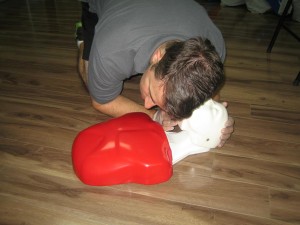When it comes to the delivery of first aid care, it is important to prioritize the ABC (airway, breathing and circulation). In case an individual losses consciousness, the first priority is to check if the airway is open, the individual is breathing and if there is a pulse or other signs of circulation such as coughing, groaning or movement. Take note that these are the ABCs in emergency first aid.
http://youtu.be/3A6LF7JqJCw
Airway
In case the victim is face down, roll him/her in a gentle manner onto his/her back. Place one hand on the back of the neck and another on the hip then roll gently over his/her back. If neck or back injury is suspected, you have to keep the head, neck and back aligned when rolling over the individual.
If you cannot roll the individual on your own, ask others to help. Using the head-tilt technique, it will open the airway of the individual. Kneel at the side of the individual and then position one hand over the brow and slightly tip the head back. Place the fingers of the other hand on the bony part of the chin, not on the throat. Lift gently the chin straight up without closing the mouth.
Check the breathing and circulation

Once the airway is open, you have to check and feel for breathing for 5-10 seconds by placing your cheek close to the mouth of the individual and observe for the rise and fall of the chest. Observe for signs of circulation such as coughing, groaning or movement.
If the individual is not breathing but shows signs of circulation, perform rescue breathing. In case the individual is not breathing and no signs of circulation, perform CPR.
Rescue breathing
If an adult ceases to breathe but signs of circulation are present, call for emergency assistance and then perform rescue breathing. If an infant or child does not breathe but has signs of circulation, deliver rescue breaths for 2 minutes before getting in touch with emergency assistance and then carry on with the rescue breathing.
For infants
- Position your mouth over the nose and mouth of the infant.
- Deliver 2 gentle rescue breaths.
- If the chest does not rise and fall, reposition the head and try again.
- Check and feel for breathing and circulation for no more than 10 seconds.
- If the infant stays unconscious but there are signs of circulation and no breathing, you have to continue to deliver a single breath every 5 seconds for a child and 1 gentle puff every 3 seconds for an infant. If there is no breathing or signs of circulation, perform CPR.
For children and adults
- Pinch the nose close using your fingers and place your mouth over the mouth of the victim.
- Deliver 2 full, steady breaths for 1-1.5 seconds.
- After every breath, all the lungs of the individual to deflate.
- If the chest does not rise and fall, reposition the head and deliver the breaths again.
- Check and feel for breathing and circulation for no more than 10 seconds.
- In case the individual stays unconscious and there are signs of circulation but breathing is absent, continue to deliver 1 breath for every 5 seconds for adults. If there is no breathing or signs of circulation, you have to perform CPR.
Always remember that one essential component of first aid care is ABC. Make it a priority during the assessment during emergencies so that proper care can be provide as soon as possible.
